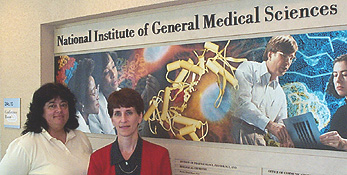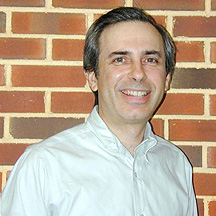
| T H E N I H C A T A L Y S T | S E P T E M B E R - O C T O B E R 2000 |
|
|
|
PRAT:35 YEARS OF TRAINING PHARMACOLOGY LEADERS |
by
Alisa Zapp
Machalek, NIGMS
|
 |
|
PRAT
co-directors Pamela Marino (left) and Alison Cole
|
"It allowed me to come to NIH and work in one of the best labs in pharmacology. It completely started my career," said Steve Paul, speaking about the Pharmacology Research Associate (PRAT) program sponsored by NIGMS. Paul, an M.D., became a PRAT postdoctoral fellow in 1976 to train in the NIMH laboratory of Nobel laureate Julius Axelrod. Paul rose to the rank of scientific director at NIMH and is now a group vice president at Eli Lilly and Company. "To this day," he said, "I continue to benefit from the work I did and mentorship I received as a PRAT fellow."
The PRAT program, a two-year post-doctoral fellowship in the pharmacological sciences, has trained leaders such as Paul for 35 years. It provides a cross-disciplinary environment for those who want to specialize in pharmacology or to apply their pharmacological training to other fields.
More than 90 percent of PRAT fellows have continued in research and research-related careers. Of these, 43 percent are in academia, 31 percent in government, and 25 percent in industry.
NIGMS, which does not have intramural research labs of its own, recruits and supports the fellows, who arrange to work in labs of their choice at NIH or FDA. Intramural senior scientists who serve as PRAT mentors add to their lab the expertise of a talented, carefully selected PRAT fellow.
The program’s overall goal—to identify and train leaders in pharmacology—has not changed significantly over the decades, but the scientific scope of the program has become much broader, say PRAT co-directors Alison Cole and Pamela Marino, who are also extramural program directors in the NIGMS Division of Pharmacology, Physiology, and Biological Chemistry.
"We’ve had fellows come in with a pharmacology background who want to learn about neuroscience or bioinfor-matics, and we’ve had biomedical engineers who want to apply their expertise to pharmacological science," Cole said.
The PRAT program moves beyond the lab as well, with coordinated activities that provide networking opportunities and expose the fellows to the breadth of pharmacological research. There are monthly presentations of ongoing research by the second-year fellows and guest lectures on topics such as grantsmanship and career development.
"Since I am now in computational biology and I don’t do wet bench experiments anymore, it’s been great to attend PRAT seminars once a month to keep in touch with my former life," said Stephen Edwards, who is a first-year PRAT fellow at NCBI. "[These seminars] are one of the nicest things of the PRAT program and they benefit even people working in the labs because they’re all working in different institutes, studying different systems, and using different techniques."
Edwards, who earned a Ph.D. in pharmacology from Vanderbilt University in Nashville, Tenn., said he also appreciates the career guidance that PRAT fellows receive from the program co-directors. "In graduate school and [typical] postdoc fellowships, they do a good job of training you what to do [in the lab], but they don’t give you much information on career paths," he said.
 |
|
Michael
Rogawski
|
"From the first meeting, the directors have given us a lot of good advice: You need to go to meetings, you need to give presentations, you need to be networking and meeting people. When the program is over, you haven’t been holed up in the lab for two to four years without any outside contact."
Some fellows had such positive experiences that they became PRAT mentors, or preceptors, themselves. Michael Rogawski, now chief of the Neuronal Excitability Section of the Epilepsy Research Branch at NINDS, became a preceptor because he "wanted to give back to the PRAT program." He received his M.D.-Ph.D. from Yale and stretched his PRAT training out from 1981 and 1984 to fit in a neurology residency at Johns Hopkins. The first fellow who trained in his lab, N. Bradley Keele, is now an assistant professor of neuroscience at Baylor University in Houston. Rogawski has just taken on a new fellow, Melissa Banks (see "PRATs Past and Present").
Before applying to the PRAT program, each applicant must develop a scientific proposal with his or her chosen preceptor. The PRAT selection committee, which is made up of NIH and non-NIH scientists, evaluates prospective fellows and preceptors as a package during the competitive application process. Each year, the program accepts six or seven new trainees.
The PRAT program originated in the mid-1960s, when there was an increased awareness of how environmental toxins such as DDT affect human and animal populations. A committee commissioned by James A. Shannon, then the NIH director, recognized the importance of understanding how chemicals interact with living systems—and that such interactions would daily grow more common. It recommended the formation of a training program to strengthen the country’s pharmacological research capabilities. Over its 35-year history, the resulting PRAT program has trained 334 fellows with senior scientists at 14 different NIH institutes and one FDA branch.
Cole and Marino hope to promote the program further at NIH and nationally and to bring intramural scientists from additional institutes onto the program’s advisory committee and into the ranks of preceptors.
The program’s success
shines through its graduates, including one Nobel Prize winner—Alfred Gilman
(see "PRATs Past and Present"). "Many
PRATs are now leaders in the field [of pharmacology]," said co-director
Marino. "They’re starting their own companies; developing their own
research labs in industry, academia, and government; and doing interdisciplinary
research." ![]()
|
text and photos by Michael Vatalaro Many PRAT fellows have gone on to highly successful careers in academia, industry, and government, but perhaps none so visibly as Alfred G. Gilman, co-recipient of the 1994 Nobel Prize in physiology or medicine. Gilman and the late Martin Rodbell, who did his prize-winning research while at what was then called the National Institute of Arthritis and Metabolic Diseases, won the prize "for their discovery of G-proteins and the role of these proteins in signal transduction in cells." In his autobiography, Gilman describes his time in the program between 1969 and 1971 as "enormously broadening."
Given its reputation and the unparalleled resources available at NIH, the PRAT program recruits a wide variety of postdoctoral candidates from around the country. The newest PRAT fellow on campus, Melissa Banks, came from Indiana University, Bloomington, where she earned a dual Ph.D. from the Department of Psychology and the Program in Neural Science. She is conducting research on epilepsy in a rat model. Her lifelong interest in epilepsy originated in childhood, with her experiencing a seizure herself and undergoing five years of treatment before the condition was vanquished. Banks said she joined the PRAT program to gain more experience in pharmacological research techniques, including in vivo work and electrophysiology and other methods. She expects that the program will enable her to work more independently than her graduate studies allowed and that she will be involved in epilepsy research after completing her fellowship. Banks works in the NINDS lab of former PRAT fellow Michael Rogawski.
Second-year PRAT fellow Catherine Booth studies with Ira Pastan in the Laboratory of Molecular Biology at NCI. She focuses on P-glycoprotein transporter molecules, trying to determine the structure and function of the proteins’ nucleotide binding domains. Her broad goal is to understand how ATP interacts with the transporter and how the transporter harnesses energy from ATP hydrolysis. Booth earned her Ph.D. at the University of North Carolina, Chapel Hill, and worked for a pharmaceutical company before coming to NIH. Booth says the PRAT program has given her the opportunity to meet and interact with her peers and has also provided many guest speakers to discuss topics relating to careers outside of NIH. Looking back over her time as a fellow, which is drawing to a close, she said the experience was "overwhelming, the first few months. The level of science is above all others. There are a ton of talented people." Booth said she hopes to continue doing applied research, primarily in the area of targeted drug delivery.
Luci Roberts, who has a Ph.D. in zoology, specializes in behavioral studies, specifically the neuroendocrinology of social behavior. Working in the Laboratory of Comparative Ethology at NICHD, Roberts examines the role of dopamine, serotonin, and related hormones in the social bonding and parental behavior of common marmosets, small New World primates that live in nuclear family units. Roberts’ research strays from the norm in behavioral pharmacology. She studies the hormones that make marmoset families happy, cohesive units. More commonly, researchers look at aggression and maternal separation and other negative consequences of hormone imbalance or deficiency. Since completing the PRAT program in February, Roberts has secured a K22 Career Transition Award, which will allow her to continue her research at NICHD for the next two years while she looks for a tenure-track position locally. "PRAT and
the K22 give me an edge," she said.
|
|
Next PRAT Cycle on the Horizon The deadline for applications to the NIGMS Pharmacology Research Associate (PRAT) Program is January 3, 2001, for positions starting in October 2001. The PRAT Program supports two years of training in laboratories at NIH or FDA for postdoctoral candidates in the pharmacological sciences and related research areas. These may include but are not limited to molecular pharmacology, signal transduction mechanisms, drug metabolism, immunopharmacology, chemistry and drug design, structural biology, endocrinology, bioinformatics, and neuroscience. PRAT Fellows receive competitive salaries as well as supply and travel funds to support research in their preceptors’ laboratories. Candidates apply in conjunction with an identified preceptor, who may be any tenured or tenure-track scientist at NIH or FDA. For more information or application materials, contact the PRAT Program Assistant by phone at 301-594-3583 or e-mail. Another PRAT program, launched two years ago and open to individuals with M.D. degrees, is designed to create a cadre of scientists in the clinical development, evaluation, and therapeutic use of small molecule- and biotechnology-based pharmacotherapy. For more information on the Clinical Pharmacology PRAT program, contact Art Atkinson at 301-435-8791 or visit the web site. |